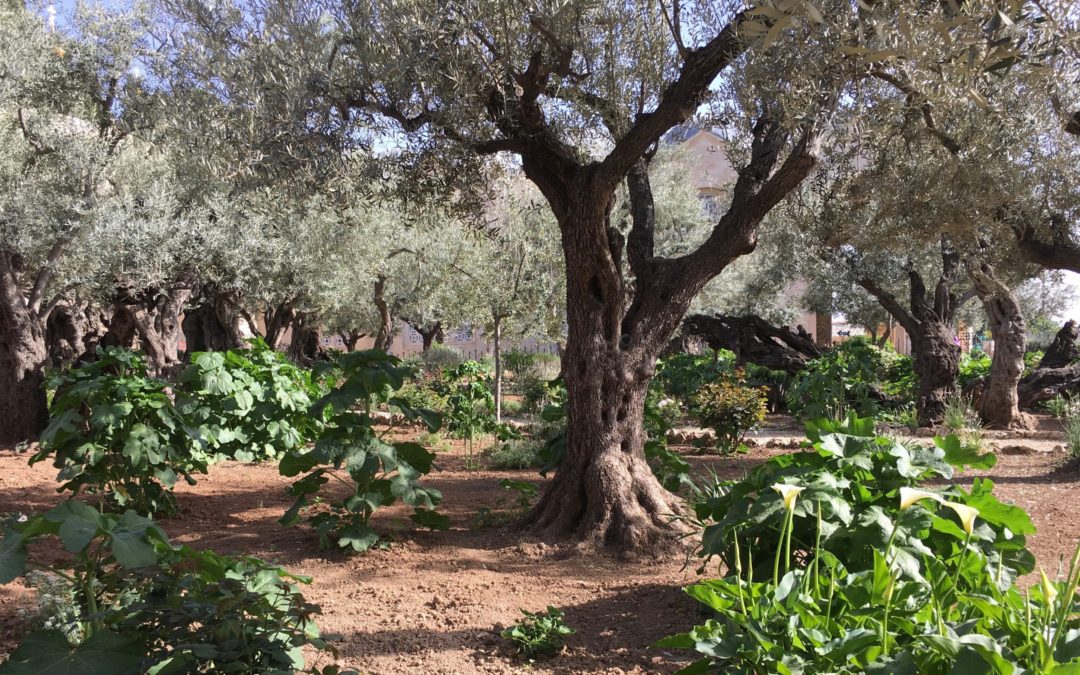
This is believed to be the location of the Garden of Gethsemane, just west of the Temple Mount in Jerusalem. (Photo by Doug Peterson)
We reached the Garden of Gethsemane after hiking down a winding, slippery road on the Mount of Olives, east of the Temple walls in Jerusalem. The pavement was so treacherous and the road so steep that we had to hold on to handrails as we weaved our way down. But we eventually made it to the traditional site of the Garden of Gethsemane—a modest, walled-off garden with many old, stout olive trees.
No one knows if this is the actual site of the garden, but it’s in the right general location, and it certainly fits the image. The age of the trees is unknown because olive trees do not have rings that mark off years like most trees. But carbon dating has estimated that some of them go back to the 1100s AD.
The word “Gethsemane” means “oil press” in Hebrew, a fitting name for the spot where the sins of the world pressed down on Jesus on the night He was arrested. It is believed there was an olive press near the garden and hence the name.
 We saw an olive press when we visited Jesus’s hometown of Nazareth earlier in our trip. The press was flanked by a massive millstone, which was used to crush the olives after fall harvest. The stone weighs about 1,100 pounds, so you get an idea what Jesus meant when he talked about someone being thrown into the sea with a millstone around his neck. (Luke 17:2)
We saw an olive press when we visited Jesus’s hometown of Nazareth earlier in our trip. The press was flanked by a massive millstone, which was used to crush the olives after fall harvest. The stone weighs about 1,100 pounds, so you get an idea what Jesus meant when he talked about someone being thrown into the sea with a millstone around his neck. (Luke 17:2)
The olives were placed in a stone pit, explained our guide at Nazareth village as he motioned toward the pit holding the big millstone. Then a donkey was hooked to the millstone, and it pulled the massive stone wheel around in a circle, crushing the olives beneath.
According to our guide, the millstone was designed to crush every bit of the olives, including the seeds, turning them into a mash that filled about 15 baskets. This was the “crushing stage,†and it was followed by the “pressing†stage.
 The baskets, which have holes in them, were hung onto the long beam of the olive press. The olives underwent three presses, he said. During the first press, no pressure was put on the basket and the olive oil simply dripped into a 3-foot deep vat.
The baskets, which have holes in them, were hung onto the long beam of the olive press. The olives underwent three presses, he said. During the first press, no pressure was put on the basket and the olive oil simply dripped into a 3-foot deep vat.
Olives are one-third oil, one-third water, and one-third mash, and the oil rises to the top. So, they just scooped off the oil, and they had what was called their “first fruits.†The first fruits, the finest oil, belonged to the Lord, and it was used by the priests in the Temple.
During the second press, they used a stone weighing about 500 pounds to put pressure on the baskets full of olives. The quality of oil from the second press was still good, our guide said, so people used it for food, medicine, and cosmetics.
But there would still be oil inside the olive mash, he said, so people used stone weights to add even more pressure and squeeze out more olive oil. Because the quality of oil from this third press was not as good as the other two, the oil was used for lamps and to make soap.
Why am I explaining all of this? It’s not like you’re going to run out to Lowe’s and buy an 1,100-pound millstone, hook it to a donkey, and crush olives. (If you do, let me know how it works out.)
Here is why I bring up the process. When Jesus was in the Garden of Gethsemane, He prayed three times. Three presses. Three prayers.
“On the last press, we put as much weight on it as we can,†our guide said. “We’re literally trying to squeeze out every single drop of olive oil we can.â€
Luke 22:44 says, “And being in anguish, he prayed more earnestly, and his sweat was like drops of blood falling to the ground.†The sins of the world pressed down on Jesus with such weight of sorrow that blood squeezed out of Him like oil from crushed olives.
It’s a powerful image.
One verse later, Jesus finished His prayers in the Garden of Gethsemane, only to find His disciples snoozing. “Why are you sleeping?â€Â he asked them. “Get up and pray so that you will not fall into temptation.â€
While Jesus prayed in anguish, His disciples were taking the easier way—sleeping. Jesus could’ve taken the easy way as well. In the Lexham Geographic Commentary, Aubrey L. Taylor points out that the Garden of Gethsemane was located close to a road often used to escape from Jerusalem. So, Jesus could’ve easily slipped away down this road and disappeared into the wilderness.
That would’ve been the easy path. But Jesus took the hard way—the way of the Cross. The way of the oil press. We all experience “presses†in our lives—pressures that seem more than we can handle. So, ask yourself: How do I respond when my life gets difficult? Do I snooze? Do I run?
Or do I face my troubles with prayer, as Jesus did, even under the pressure of a hundred rocks?
By Doug Peterson
